
Calliarthron tuberculosum
Coarse Bead Coralline Alga
11 December 2024
Amphitrite Lighthouse Beach, Ucluelet, Vancouver Island, B.C., Canada
Tide: receding to a 2.7 foot low at 15:20 PST (measured at Ucluelet Tidal Station)
Weather: Overcast, light SE wind in Bay, SE 20 to 30 km/hour offshore, moderate SW swell offshore, sea choppy, humidity 71%, 10 ˚C.
Moon: Waxing Gibbous (83.4%, 11 days); Next phase, Full Moon, 15 December 2024 at 1:01 am PST; Previous Phase, First Quarter, 8 December 2024 at 7:26 am PST.
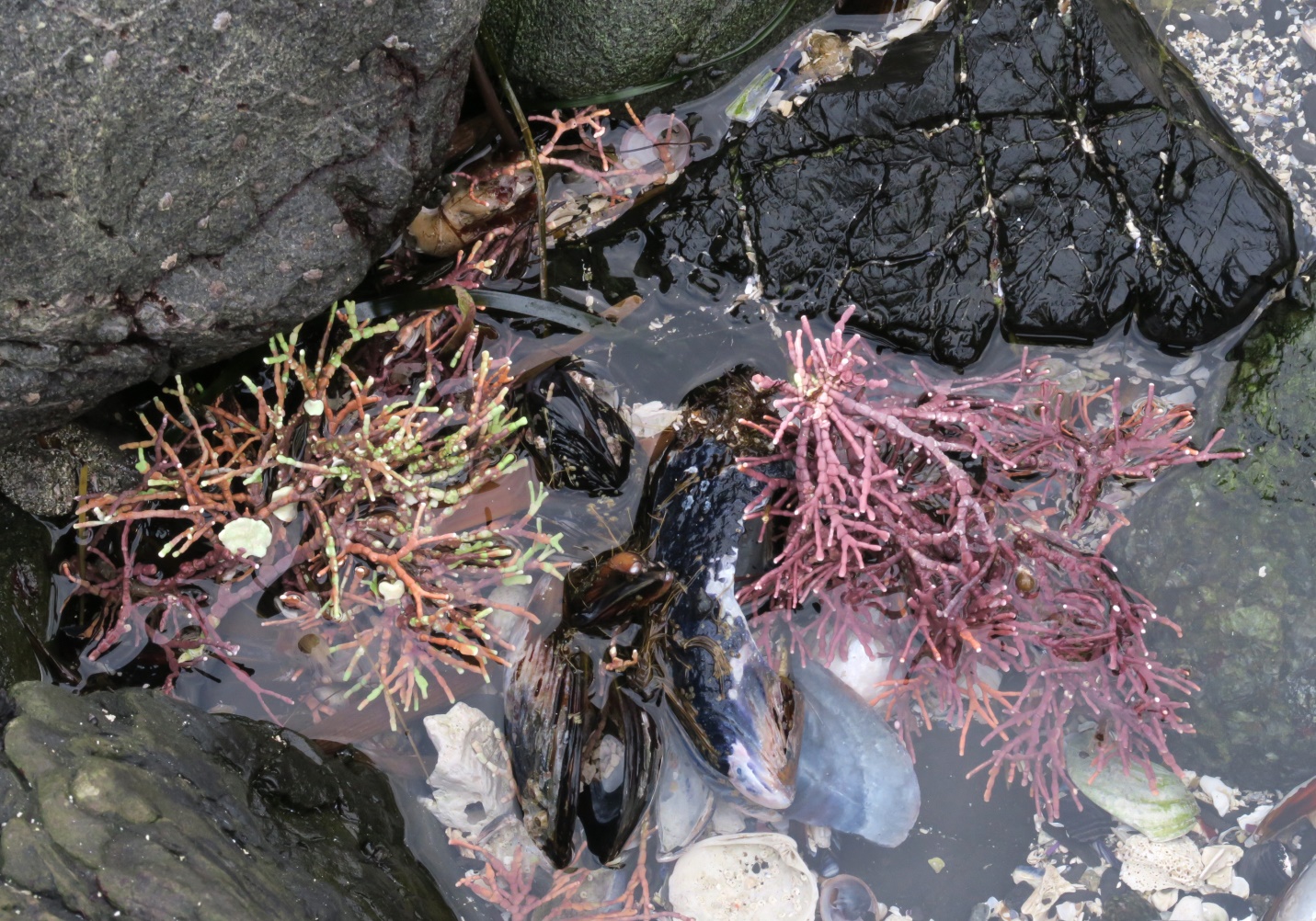
Figure 1: Cast ashore along the beach this day were many, many fronds of Coarse Bead Coralline algae. When alive this seaweed is a pinkish grey color and as it dies, the pink shade varies as it ultimately fades to white. There had been large wind storms in the region prior to our visit and there were many types of marine algae cast ashore – late fall storms manage to do their ‘pruning’ work above the water’s surface and somewhat sub-tidally, too. Big Beach, Ucluelet, Vancouver Island, B.C., Canada. December 11, 2024. Photo ID 27755 ©Seaweedwhisperings.com
Person 1:
Definitely calcareous.
Flattened bead-like segments.
Looks stiff, awkwardly rigid.
But, in reality, it can flex at any of its joints.
Seems to be trying to branch dichotomously to many orders, but doesn’t quite succeed in an orderly fashion. This lack of success in “the goal” doesn’t bother C. tuberculosum. It just keeps making more branches in different directions.
The segmented axes are flattened.
Whitish branch tips are conspicuous - quite showy on living specimens underwater.
Might be quite belligerent as it grows, perhaps dominating its neighbors. It doesn’t seem to be overly friendly.
An inner cord defines this axis; it is oval in cross-section and is a lot softer than the outer surfaces of the ‘beads’.
When fully formed, a segment has a distinct shield appearance. Perhaps it is a “battle shield”, useful for setting out to conquer the world with not much more than “guts” and no thought of the consequences of not being fully prepared.
Upon trying to get up after sitting on the beach (after recording these field notes on C. tuberculosum) my leg muscles were extremely stiff and I had difficulty getting up and changing position. The stiffness did not quickly abate; it was notable.
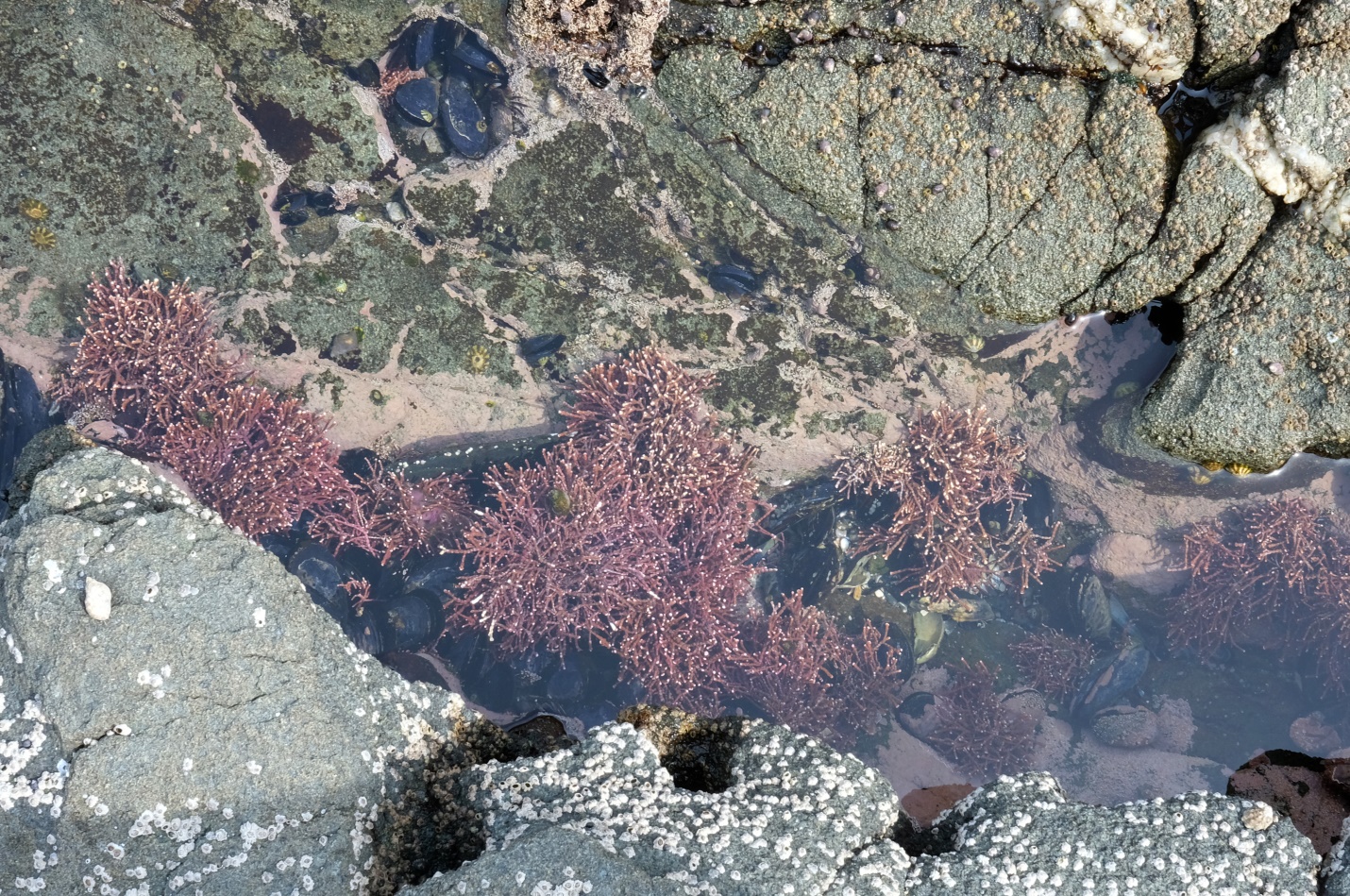
Figure 2: Just a bit further down the coastline of Vancouver Island living clusters of Calliarthron tuberculosum are pictured here in a tide pool. Even from a distance their lit up “light bulb” tips and their not quite ‘organized’ yet spacious and open branching morphology give clear hints as to which coralline algae you are observing. Botany Bay, Juan de Fuca Strait, Vancouver Island, B.C., Canada. May 17, 2022. Photo ID 27756 ©Seaweedwhisperings.com
Person 2:
The first thing I thought of – this was after combing the drift line on the beach to find several cast ashore fronds of Calliarthron tuberculosum, was to ask: “Do you want a cookie?” This is not how I have commenced my Whispering interactions with any other seaweed! I can’t say that I felt overly hungry at the moment, but I definitely was thinking about eating (and cookies were the only food item available in my backpack to offer). I wondered if this seaweed has a strong concern about nourishment?
Coarse Bead Coralline alga is indeed, segmented, calcareous, pink or pink-grey, often with rounded white tips at the terminus of branches; it looks rather NOT plant-like, not even truly seaweed-like.
Hard protective coating – I can’t penetrate the individual segments with my strongest finger nail. I can’t even make a dent. This seems to be a seaweed that is closer to a mineral than a plant!
Ah, but there are the joints, and here there is some possibility of movement. Articulated joints – these joints connect each of the ‘beads’ of algal ‘stone’ together in a more-or-less tidy form.
Most of the individual segments are not cylindrical but are flattened out somewhat; some with protrusions or ‘wings’ to their sides, and following along the string of beads, every so often a branch is produced. The branching seems random in pattern. Sometimes it is opposite; sometimes alternate; sometimes there seems to be no pattern at all!
It feels like you do not grow with any speed. Perhaps that’s why I wanted to eat; a reminder to take what calories you can whenever you can get them.
How do you receive sunlight through your armored calcareous surfaces?
Do you value the protection of your armor over anything else? Including easier production of energy?
What are you so fearful of or so vulnerable to, Calliarthron?
Why do you need such a strong barrier to the outside world?
At one place on one individual I found a “growth” that I would describe as reminiscent of mistletoe on a tree. It is a clump of the same stony pink material affixed to one segment, and the clump had numerous knobby hard projections. It looked like some tiny pottery project built by a total free-thinker on the art form! Could this have been a repair to damaged tissue? A new growth expression that didn’t work out very well? An invading external pathogen that was captured and contained? Only Calliarthron tuberculosum knows for sure, and I found that it wasn’t in the mood to divulge the truth on this matter.
Maybe you are so relatively long lived, Calliarthron, that you end up susceptible to disease, such as a marine type of mistletoe, and also longevity means you become ‘part of the landscape’ and thereby prone to settlement by other ‘hanger’s on species’ – such as the epiphytic Coralline discs. Here today I found many C. tuberculosum individuals that were hosting this second calcareous seaweed on its older more basal segments.
Small, slow growing, self-protected and long-lived - flattened fans of pinkish beads. Overall, this is an attractive look; however, close scrutiny reveals a bit more of “a mess”. This mess sometimes really remains disorganized; other times it carries on creating patterns that are rather beautiful.
In other interactions with this seaweed the white leading tips made a lasting impression – I likened them to little “light bulbs” – they contrast so strongly with the predominant pinky-grey coloration of the thallus. This light bulb concept is alluded to by authors / cartoonists when someone has a sudden and clear and new thought – it is like a light bulb is suddenly illuminated in their minds. Calliarthron has this feel to them, too. They take great delight in enjoying ideas as they occur.
Longer lasting efforts connected to these “bright ideas” do not seem to be carried out so much. That becomes a drudgery and Calliarthron’s energy is not suited to persist at dull or uninspiring mental work.
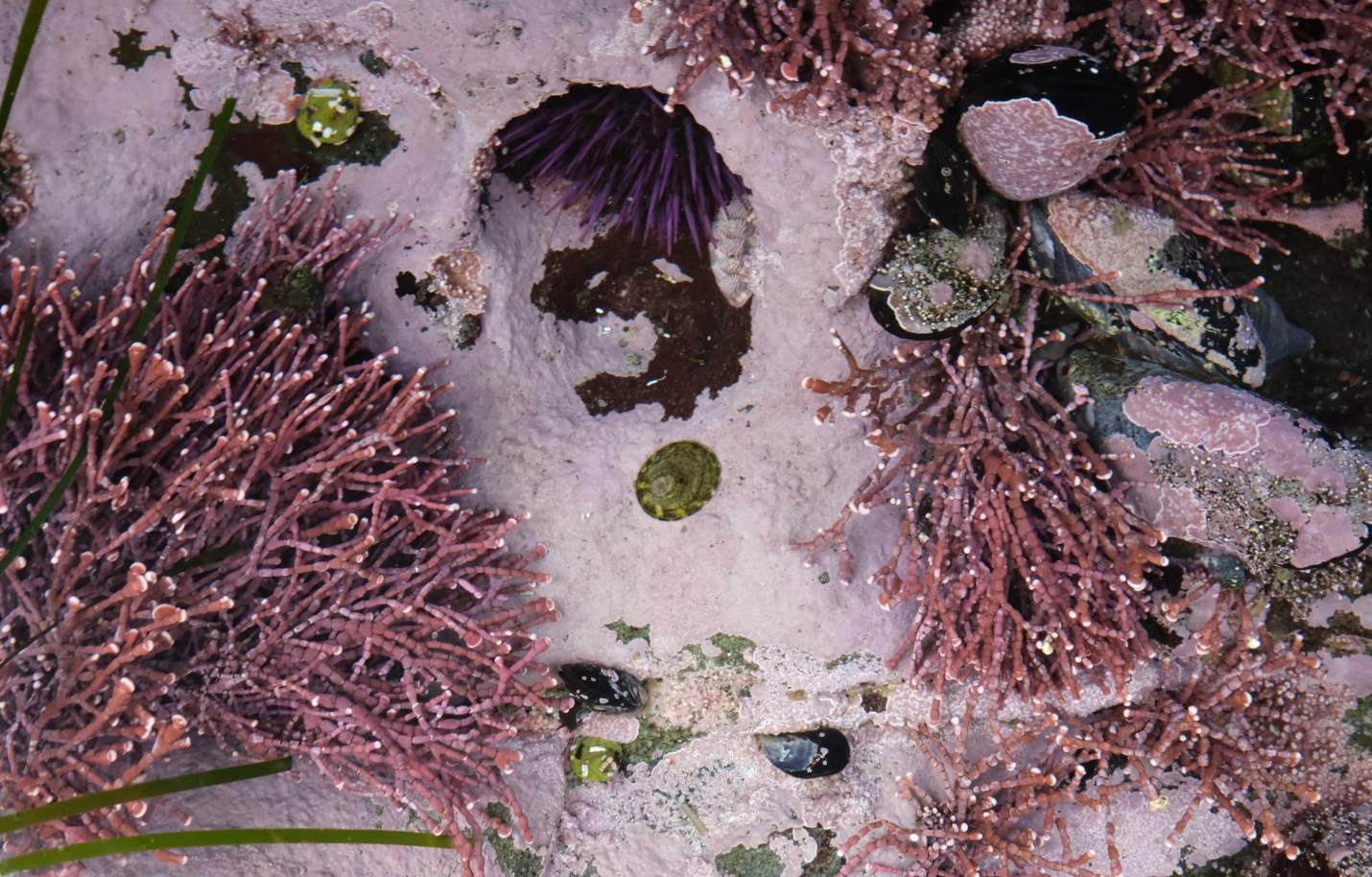
Figure 3: Friendly neighbors..., or not? Who is more belligerent, the Coarse Bead coralline algae or the purple sea urchin? In this photo it looks like the urchin has had to retreat to its ‘cave’ while the coralline algae, with their external calcareous “battle shield”, dominate the scene. The “light bulb” tips are also showing brightly against the pinky-grey thallus. Botany Bay, Juan de Fuca Strait, Vancouver Island, B.C., Canada. May 17, 2022. Photo ID 27757 ©Seaweedwhisperings.com
Discussion:
We saw that this seaweed is one that ventures out without too much thought into what it is doing. And it is not overly concerned about being organized in this either. It doesn’t prepare for heading out, it just heads out. This is true with their ideas, too – they can venture out into new thoughts and land on bright concepts but they won’t be able to retrace that thinking to document or teach it.
When fully formed, each segment of this seaweed has a distinct shield appearance. Perhaps it is a “battle shield”, useful for setting out to conquer the world, especially as Calliarthron does – with not much more than “guts” and no thought as to the consequences of having no ‘battle plan / strategy’ and little in the way of any other preparations either.
There is also what could be seen as an opposite theme to the ‘just venturing out’ trait of this seaweed in that it seems to maintain its position once it is established. And it maintains this in a way that can be sometimes annoying to others. There was the sense that this seaweed is not ‘overly friendly’ and it reaches its maximum size only quite slowly. So, it can sometimes appear that Calliarthron hasn’t got to its position in the neighborhood via the ‘normal channels’ or what might be called the most typical progression. Others can feel annoyed and even envious. However, there is another side to this story. The extensive turfs this seaweed can form also create an intertidal habitat that is helpful to a variety of other marine life, even acting as a nursery to young or otherwise vulnerable individuals. So its very existence, combined with an ‘unfriendly nature’ that repels certain others, can play a sustaining role to populations of certain life forms. In one very large tide pool we observed a Pacific octopus camouflaging itself to the mottled pink and white coloration as it hid itself safely next to Calliarthron tuberculosum. This was the most surprising example we’ve witnessed, and given the diversity of marine life that exists, we are certain many more examples of this trait are common. Calliarthron repels some things and also protects some things, too. In light of the fuller picture, perhaps ‘unfriendliness’ is in this seaweed more of positive than one might first think.
We caught the aspect that, at times, this seaweed is “not in the mood to divulge the truth”. This is one way they can be ornery and even antagonistic or, alternatively, simply uncooperative and self-contained. There is also the consideration that often times Calliarthron can’t remember the truth. They don’t seem to hold onto the past, including their own thoughts and experiences.
Calliarthron is relatively rigid and shielded to outside input; they approach the world with their set of ideas and that suits them perfectly well.
When they come across a new insight or a bold new idea, they light up with delight. This is the pure joy of discovery that they fully embrace when it occurs.
Person 2’s first thought of: “Do you want a cookie?” – we came to read this comment once again as we started transcribing the field notes to a computer document and when we did so we burst into laughter. It was a spontaneous belly laugh that was simply delightful to enjoy. With this seaweed there can be very simple pleasures, both of physical sensations and heartfelt emotions, and they are experienced utterly as they occur.
Sophistication or complexities are not necessary and actually are preferably avoided by Calliarthron. Wholehearted presence to what they have or what they have “landed on” can be quite wonderful in and of itself.
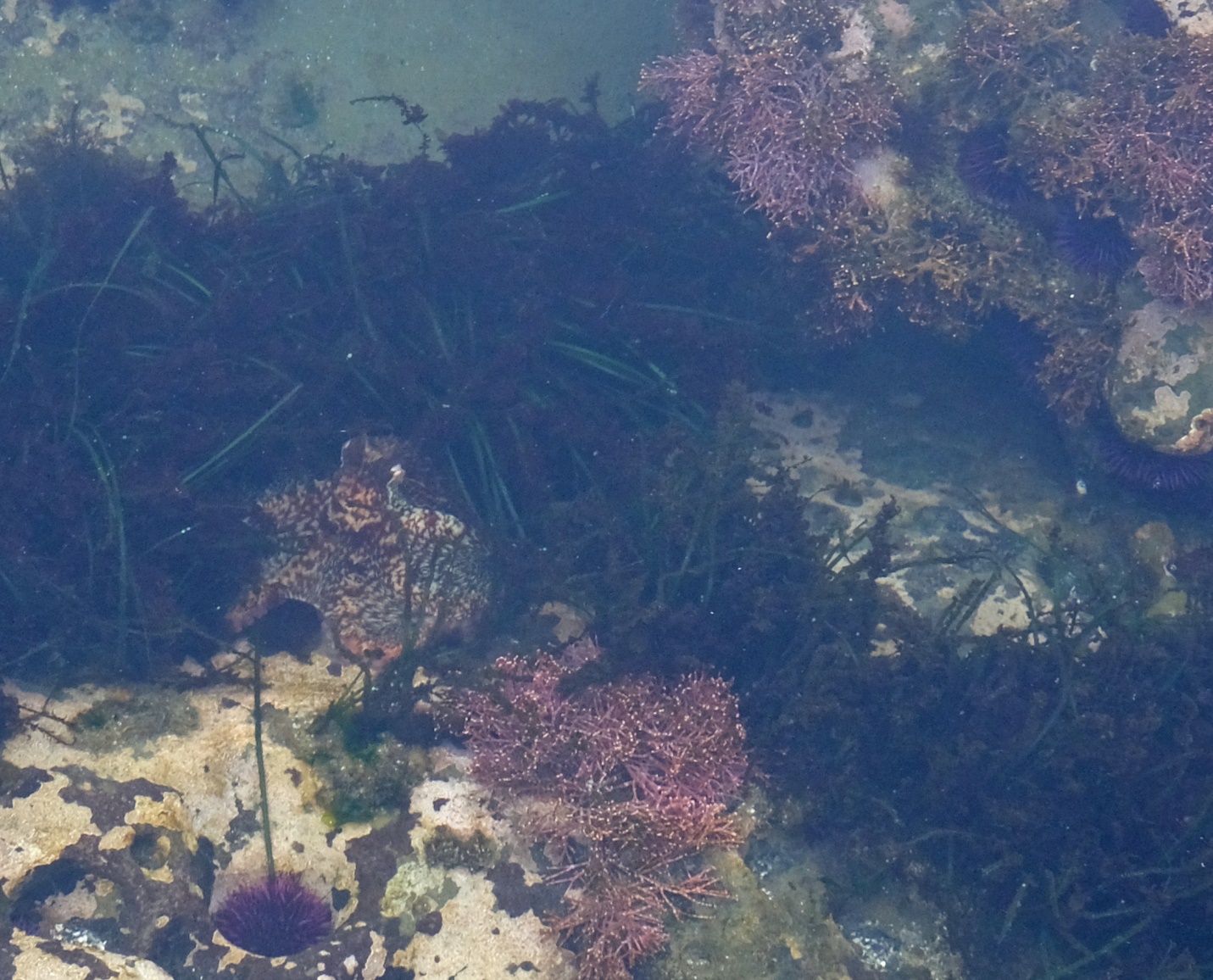
Figure 4: In this very large tide pool there is seagrass growing (the green blades covered with and somewhat obfuscated by the frilly red alga, Smithora naiadum) and there are many groupings of the pink articulated coralline seaweed, Calliarthron tuberculosum. Just above and to the left of the foreground cluster of C. tuberculosum is a young common Pacific octopus. The octopus had just recently moved to this location and changed is coloration to mimic and blend in with the pink and white algae. While it is known that coralline algae provide habitat and shelter to diverse marine organisms, this sighting was another demonstration of that ecological contribution. Botany Bay, Juan de Fuca Strait, Vancouver Island, B.C., Canada. May 17, 2022. Photo ID 27758 ©Seaweedwhisperings.com

Figure 5: This photo, and the inset (upper right), depict some of the results of being a relatively long-lived perennial alga. The main photo shows several Coralline Disc alga, Neopolyporolithon reclinatum – the flattened and roughly rounded discs with dots on their surface. These disc algae live epiphytically on the Coarse Bead Coralline alga. The inset, shows the ‘weird’ mistletoe-like growth on one segment of the older washed ashore individual of Calliarthron tuberculosum – was this a repair to damaged tissue? A new growth expression that didn’t go too well? An invading external pathogen that was captured and contained? Only Calliarthron tuberculosum knows for sure. Amphitrite Lighthouse Beach, Ucluelet, Vancouver Island, B.C., Canada. December 11, 2024. Photo ID 27759 ©Seaweedwhisperings.com
Biology & Natural History Information:
Description:
A perennial, calcified, articulated, coralline alga that grows from a crustose base, Calliarthron tuberculosum is a pink or greyish pink in color. The calcified segments have pores on their margins and flattened surfaces and are called intergenicula; these segments are separated from each other (like pearls on a string) by un-calcified genicula. This morphology gives the needed flexibility required for meeting strong water movement to what would otherwise be a very rigid seaweed. The branching pattern can be pinnate, dichotomous or irregular and can yield a bit of a disorganized look to the fronds. Calcified fronds grow slowly, only 1-2 mm per month, and individual fronds may live more than six years and reach up to 25 cm tall. In ideal habitats these wiry fronds can form a dense and sometimes expansive colorful pink turf in the lower intertidal. Calliarthron reproduces by means of conceptacles.
Habitat:
This species is abundant in tidepools and on rock in the low intertidal and shallow subtidal of moderate to exposed habitats.
Distribution:
Calliarthron tubercuclosum is found along the NE Pacific (the west coast of North America), from Prince of Wales Island, Alaska to Baja California, Mexico. It is not known from any other coastlines in the world.
Remarks:
The genus name, “Calliarthron”, is translated to mean beautiful joints. “Arthron” is from the Greek for joints or articulation, and is the same root for names of disease conditions involving the joints such as arthritis. While several sources note that “calli” is derived from the Greek word, “kallos”, which means beauty, and as an adjective, the very similar Greek word, “kalos”, meaning “beautiful” or “fair”, it is the second meaning, fair, that fits this seaweed well; the articulations of this seaweed – the spaces between the calcareous beads, are ‘light’ or ‘fair’ in coloration compared to the rest of the thallus. So it is therefore a seaweed that has “light colored joints”.
A visually similar species, Calliarthron cheilosporioides, is found typically in the subtidal (rarely the low intertidal) and overlaps the southern part of C. tuberculosum’s range from Monterey County, California southwards to Baja California, Mexico.
Studies have shown that increased acidification of the world’s oceans has a negative impact on Calliarthron tuberculosum and four other articulated coralline relatives – Corallina officinalis, Corallina vancouveriensis, Bossiella orbiginiana and Bossiella plumosa. Short term increases in acidification resulted in declining calcification for all the named species. Overall their growth and size was diminished, and given that coralline algae act as a ‘nursery’ and provide habitat for a diverse number of animals and other seaweeds, the decline of coralline algae is concerning factor for the overall health of marine ecosystems.
Classification:
Phylum: Rhodophyta
Class: Florideophyceae
Subclass: Corallinophycidae
Order: Corallinales
Family: Corallinaceae
Subfamily: Corallinoideae
Genus: Calliarthron
Species: Calliarthron tuberculosum (Postels & Ruprecht) E.Y.Dawson 1964
Former name(s): Corallina tuberculosa 1840. Other synonyms are listed with AlgaeBase.org
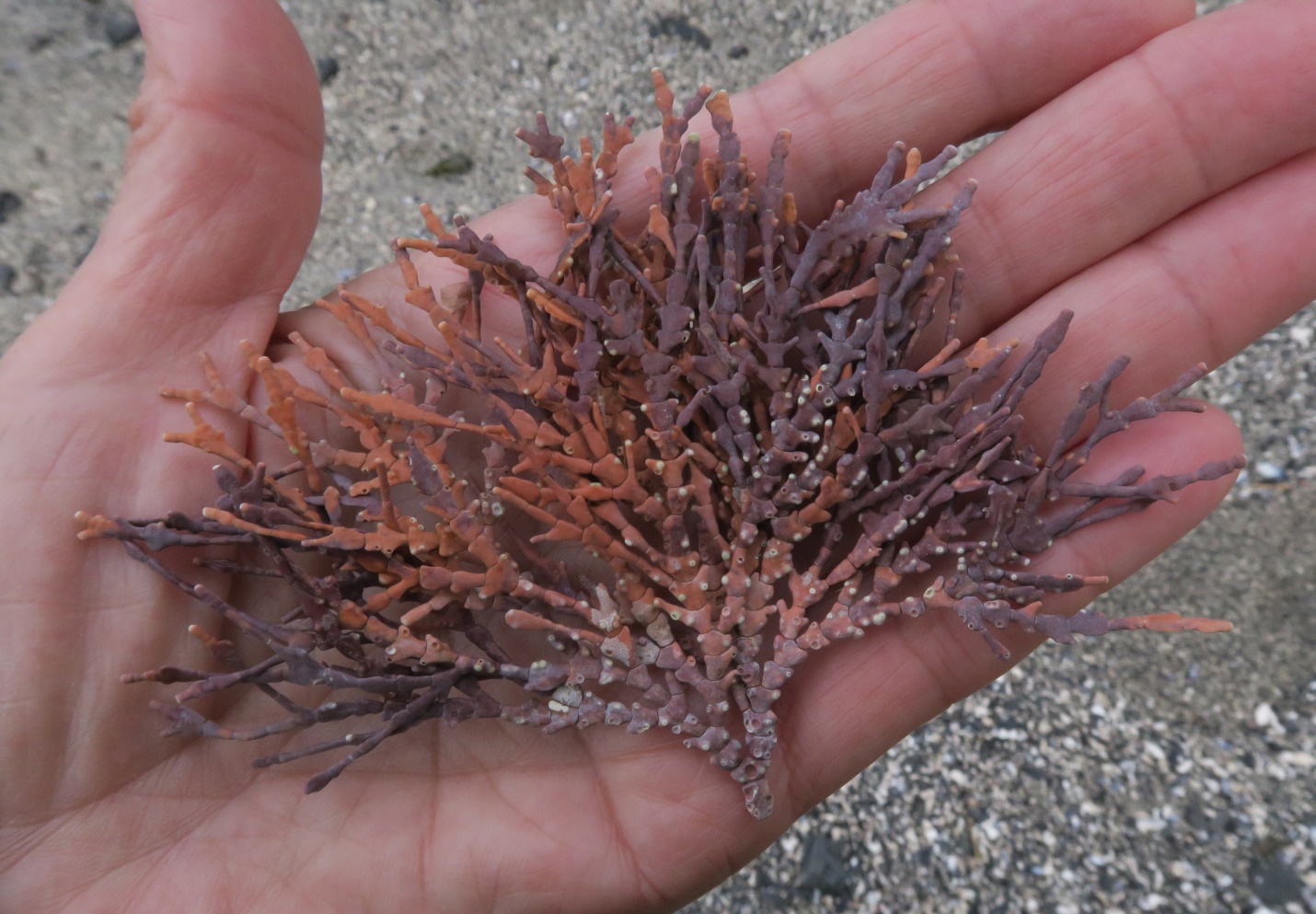
Figure 6: The white ‘bumps’ on the margins of the segments of this individual are reproductive conceptacles. The overall ‘sunset hues’ coloration is quite showy in this cast ashore individual, however a uniform grey-pink tone is the more typical healthy color of the live seaweed. Big Beach, Ucluelet, Vancouver Island, B.C., Canada. December 11, 2024. Photo ID 27760 ©Seaweedwhisperings.com
![]()